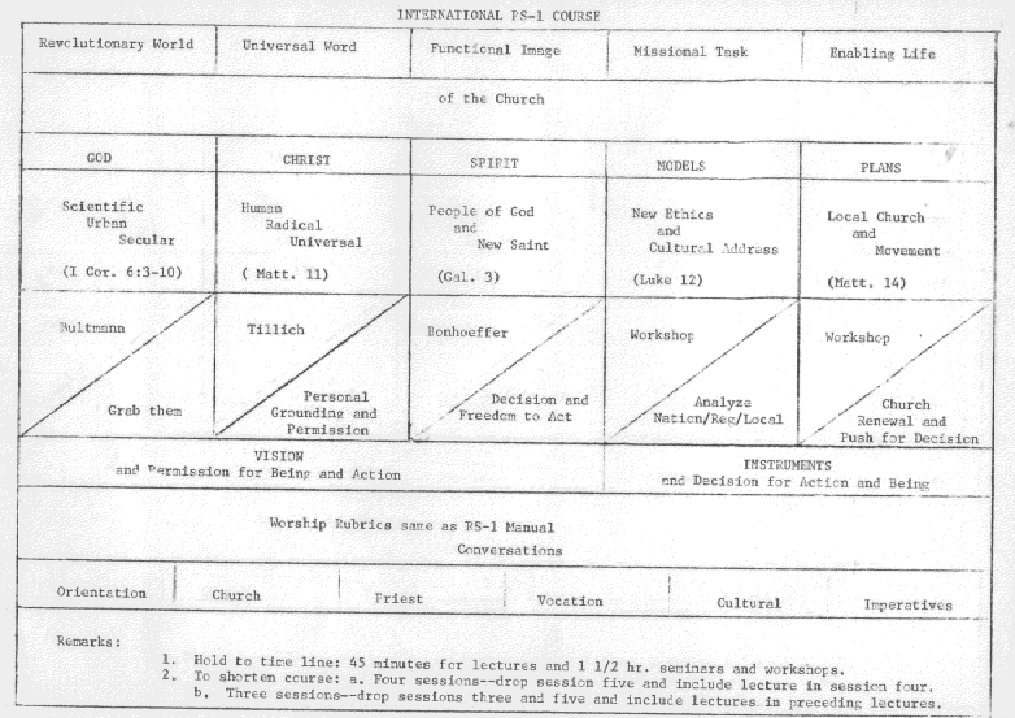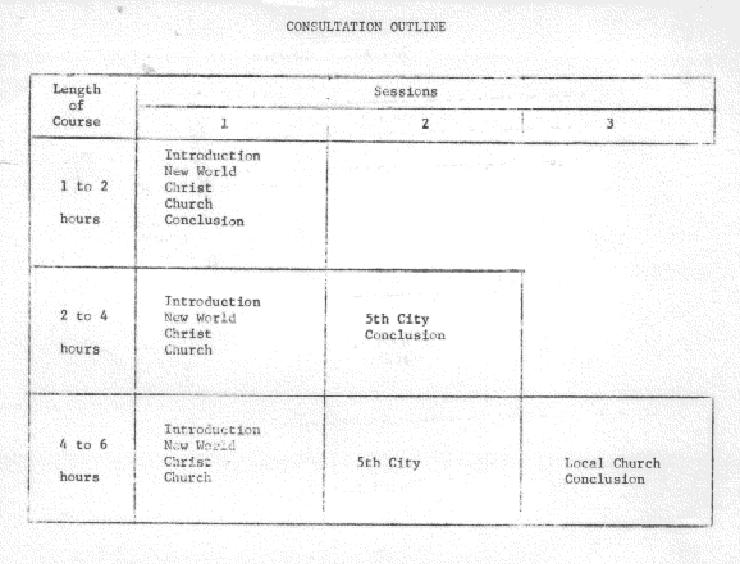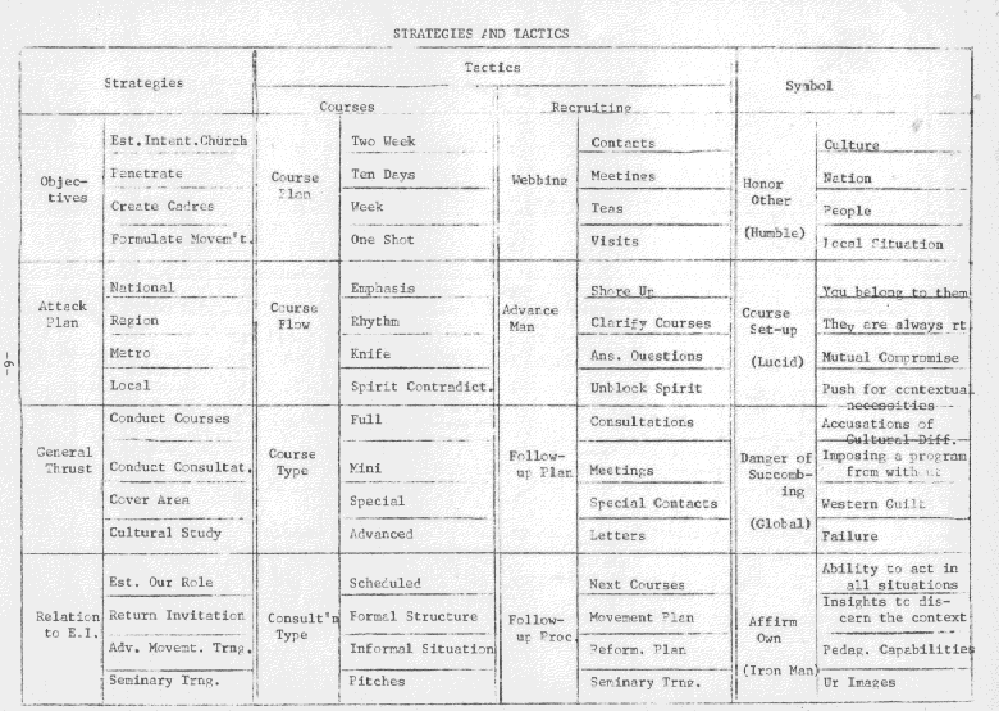

INTERNATIONAL PENETRATION
Ecumenical Institute: Chicago
Manual of Operations
I. Course Outline
II, Consultation Outline
III. Lectures and Seminars
IV. Workshops
V. Conversations
VI. Strategies and Tactics
page
1
2
3
4
5
6
 |
 |
Consultations usually consist of 1ectures followed by periods for questions and answers.
Consultations may be of any length from a fiveminute pitch to six hour sessions.
Meals may be used for conversations where applicable.
Introduction is the same as the introduction to the beginning meal conversation of the course.
Conclusion includes passing out material and getting names for mailing list.
LECTURES and SEMINARS
LECTURES
I. Cultural Revolution
Scientific
Structure
Substance
Quality
Mechanics
lV. New Ethics and Cultural Revolution
A. Justing Love
1. Justice/ Charity
2. Social Structures
3. Dogoodism Collapse
4. Response to Divine Activity
B. Contextual Ethics
1. History
2. Responsibility
3. Perversions
4. Model Building
Secular
Encounters
Response
Conflict
Authority
C. GeoSocial Model
1. Description
2. Grid
3. Analysis
4. Problemat
*D. Cultural Analysis
1. History
2. Relation to Western Civil.
3. Cu1tura1 Gift
4. Future Role
*Cultural Analysis chances for each cultural zone.
V. Local Church (bug)
A. Witnessing Love
1. Secret
2. Call
3. Power
4. Presence
B. Worship / Study
1. Symbolic Life
2. Worship rationale
3. Study Rationale
SEMINARS
I. Crisis of Faith
II. You Are Accepted
III. Freedom
C. Fellowship
1. Maintenance
2. Sustenance
3. Planning
4. Accountability
D. 5th City
1. Context
2. Presuppositions
3. Development
See RS1 manual
See RS1 manual
See RS1 manual
Urban
Space
Time
Relations
Rootage
Reformulation of Society
WORKSHOPS
Renewal of Church
II _
Introduction
1. Purpose of Grid
2. Gestalt in of Problemat
3. Function of Workshop
Assignment
I. Grid
a. Nation
b. Region
II. National Problemat
a. 9 eco. problems, Reduce to 5
b. 9 pol. problems, Reduce to 5
c. 9 cult problems, Reduce to 5
d. Reduce 15 problems to 5
III. Regional Problemat
(same as for Nation)
Assign all individuals to do the grid
Assign problemats to total body
divided into groups of 3 to 8.
Questions to ask while they are putting work on the board.
2. Conducting Workshop
a. Gridding. Push for values
and provincialism behind grid
b. Problemat
1. Method of gestalting
2. Give suggestions where needed to break loose.
3. Show eco., pol., cult
4. Must end up with THE 5 problems.
Lecturettes
.
1. Lynch model. Use in relation to city cr parish illustration.
2. Workshop methodology
3. New Left
Remarks
It is crucial that they have an adequate grid of the nation. They must arrive at a consensus of the five major problems of the nation. Share with them the common grid and problemat that has come out of previous courses.
Introduction
1. Concrete plans; not abstractions
2. Plans must be what they can do, not others.
3. Plans must demand action or concrete response.
Assignment
I. 9 point plan for renewal of church in the nation. Reduce to 5.
II. 11 point man for renewal of church in region. Reduce to 6.
III. 13 point plan for renewal of your local church. Reduce to 7.
Assign each to total body divided into groups of 3 to 8.
Practics
.
1. Questions to ask while they are
putting work on the board.
a. What are the major obstacles to radical renewal of the church in the nation.
b. Same for their local church.
2. Conducting Workshop.
a. Push for concretions.
b. Push hard for nation plan to be workable and comprehensive
c. Push for local congr. plan to be radical end comprehensive.
Lecturettes
1. Local Church ( 3 triangles)
2. Battle plans
3. Congregation Organizational, training and Operational (time line) plans.
Remarks
This is probably the hardest and most crucial session
of the course. Push hard to explode their vision that something
can be done, and insist; that their plans be concrete. This workshop
culminates the images, tools, and possibilities for decision.
CONVERSATIONS
I. Orientation:
A. Introduction
1. Sacred land
2. West forced to understand East (South).
3. East (South) role in future.
B. Who Ecumenical Institute is
1. Revolutionaries change church/ change world. Practical, grass root, structural.
2. Reeducation Program and Community Reformulation.
3. Use ourselves as guinea pigs for experimentation.
C, Go around Purpose: Get their names and voices out. To say who they are.
1. Names
2. Church
3. Location
II. Church Problems
III. Priesthood
IV. Vocation:
A. Purpose: to pround their life historically before God. B. Sample questions:
T. What is the most important happening in the 1st 2/3 of the 20th Cent?
2. What will the year 2000 be like? (Push until eco., pol., cul., changes come out.)
3. If 5 or 6 college students majoring in engr., medicine, business, etc. come to you and ask what vocation should they take (in view of the description of year 2000) what would he your response?
4. What is your vocation in view of the above?
V. Culture:
A. Purpose. to sensitize them to the gift of their Ur and their role
in history.
B. Sample questions:
1. If you had to live the rest of your life in some other country than this one, which would it be?
2. If your country (culture) was to be captured (by pestilence, etc.) in 1975, what would you start now to do?
3. What is the unique contribution of humanness your culture has to contribute to global humanness?
Or
What is the role of your country in world history?
VI. Imperatives
In addition:
See RS1 manual
1. Push for cadre establishment.
2. Push to tie into movement.
3. Push for future meetings (where applicable)
4. Announce return dates.
 |
I. Institute a systematic Nationwide intensive reeducation Movement.
1. Systematic recruitment effort
2. On a regional basis
3. Penetrating every religious body
4. And strata of society
5. For a weekend core course.
II. Create a systematic complex of geosocial operational grids for
the Nation.
1. Grid the world for the nation.
2. Grid the nation for the region.
3. Grid the region for the sector.
4. Grid the sector for the metro.
5. Grid the metro for the parish.
III. Organize a nationwide network of catalytic task force cadres to
A.) Attack community reformulation and
B.) Be a sign in attacking problemats.
1. National cadres formed out of...
2. Regional cadres formed out of...
3. Sector cadres formed out of...
4. Metro cadres formed out of...
5. Parish cadres formed out of congregational cadres.
IV. Establish systematically interrelated Regional Training Centers
throughout the nation.
1. On a regional basis
2. Create faculties to teach a
3. Common curriculum
4. With coordinated schedules in
5. Relation with consultation programs.
V. Formulate a nationwide construct of common strategic objectives.
1. Local church: cadre, congregation and parish
2. Operating grids
3. Problemats
4. Battle, Training and Operational Plans
5. Indigenization program